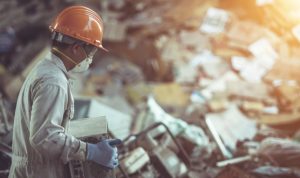
How to Properly Dispose of Hazardous Waste?
What is Hazardous Waste?
Motor oil, huge battery packs, laptop, paint, cleaning solvents, old TVs, household appliances, and cellphones are just a few examples. When it comes to disposal, these products, along with a slew of others, become hazardous waste.
Hazardous waste, in general, refers to any waste that poses a risk to human or environmental health if it is not properly disposed of. Hazardous waste is anything flammable, reactive, corrosive, poisonous, or explosive under specific conditions.
Types of Hazardous Waste
Industries, medical establishments, and even schools can generate several sorts of hazardous waste. It’s important to remember that not all waste is harmful, but that doesn’t mean non-hazardous waste can’t cause problems.
So, what exactly is hazardous waste? The answer is simple, waste with qualities that make it dangerous or capable of having a detrimental effect on human health or the environment is considered hazardous waste.
Here are some of the most prevalent types of hazardous waste found in businesses.
- Electronic Waste
- Medical Waste
- Chemical Waste
Electronic waste
Electronic garbage contains toxic elements that can affect both the environment and human health. Because chemicals and substances including mercury, arsenic, cadmium, and lead can be found in electronics. Lead, in particular, can harm the nervous system.

e-waste is generated in almost every business, whether it’s from replacing computers that contain beryllium oxide following a system upgrade, swapping out mercury-containing lightbulbs, or replacing sulfur-containing batteries.
Medical Waste
Testing facilities, labs, pharmacies and hospitals are all potential sources of medical waste. In the UK alone, hospitals alone generate 600,000 tons of medical waste each year.
While 85 percent of the trash generated by healthcare facilities is classified as non-hazardous, this does not mean that its disposal is unregulated. This is where certain parts of medical waste removal become crucial, such as the medical waste disposal containers you choose and the vendor you work with to ensure all regulations are followed.
Chemical Waste
Many chemicals are utilized to improve the quality of our lives, and the majority are not detrimental to the environment or human health. But some chemicals like pesticide wastes have the potential to damage people in specific concentrations and should only be used when the risks are properly managed.

Chemical waste can be found in a wide range of places, including manufacturing plants, high school labs, and hospitals. Chemical waste poses a significant concern to not just the environment, but also to lab personnel, students, and neighbours who live in the vicinity of lab facilities.
How to Dispose of Hazardous Waste?
Incineration
Most House Hazardous waste (HHW) is destroyed and terminated during incineration. The combustible garbage can also be burnt and used as an energy source, which provides a benefit to society. Incineration emits harmful chemicals that can harm the environment, but modern technology has resulted in more efficient incinerator units that reduce the number of emissions emitted into the atmosphere.
Recycling

Recycling is also a good idea. Have you ever seen the cell phone recycling machines at Staples or an Office supply store? The idea here is to recycle or reclaim the phone’s battery and parts rather than simply discarding them. Oils that have been used can also be saved and repurposed. Recycling waste is the most environmentally friendly option you can think of.
Disposal Box
If you have diabetic syringes or prescription medicines, you must dispose of them with extreme caution! In most pharmacies, you can dispose of spent syringes in a small disposal box. Prescription medications should be delivered to a drop-off place at all times! They should never be thrown away, flushed down the toilet, or poured down the sink!
Landfill disposal
The most prevalent and oldest technique of garbage disposal is dumpsites and landfills. Hazardous waste landfills are designed specifically for hazardous waste and are not designed to hold liquid waste. They are designed and built to be contained within the earth, rather than accumulating upward.

To prevent the garbage from leaking into the earth, these landfills are lined with clay, HDPE, or other non-porous materials. Wind dispersal controls, a leak detection system and a double liner are among the additional precautions in place to guarantee that as little waste as possible gets into touch with humans and the environment.
Donate It
Last but not least, sharing hazardous garbage is a great approach to getting rid of it! For example, if you have extra oil or fertilizer, you can give it to someone who is in need!
We may all benefit from a safer environment if we use these strategies to dispose of hazardous garbage. Be a responsible citizen of the country. Try to follow these methods when you suppose to dispose of some hazardous waste by yourself or you can seek a professional removal service to do the job for you.